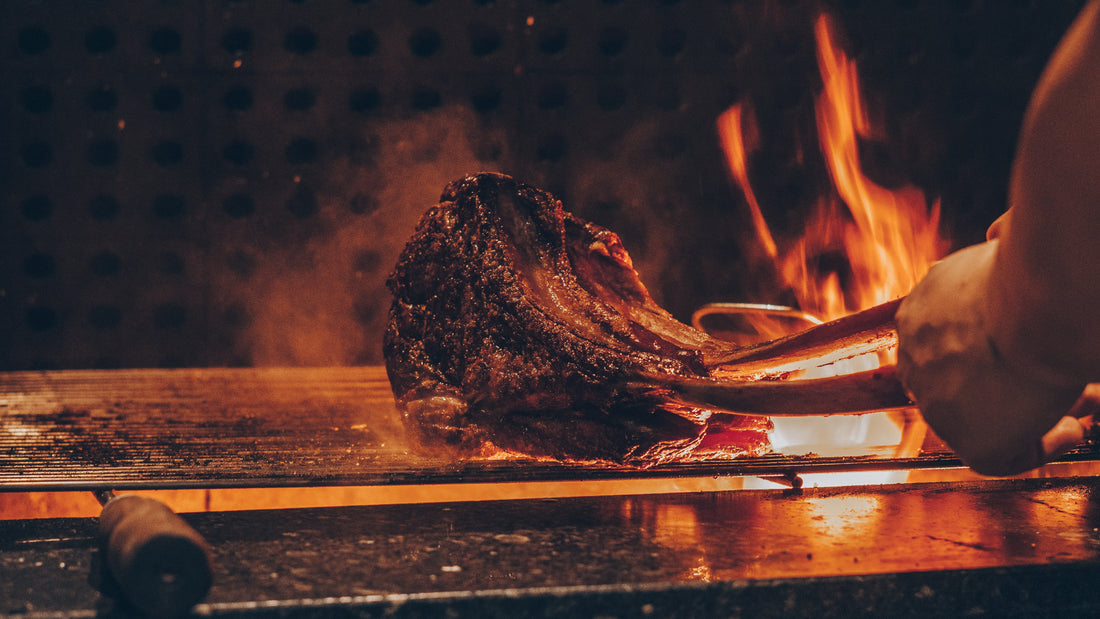Ask ten people the best way to grill a steak, and your liable to get at least nine good answers (Anyone who grills well done doesn’t count as a good answer). Many grillmasters and chefs will passionately defend their specific methods of grilling steaks as “The Best Way” – even if they contradict each other.
Some charcoal grillers will insist that you add small chunks of hickory on top of the coals for flavour, while others will insist that the blocks go under the coals to avoid ruining a steak. Some insist on high heat from start to finish, and some sear on hot then bring steaks up to temperature on a cooler section of grill.
The truth is that while there are a lot of varying styles that can subtlety alter the flavor of a steak, all great grilled steaks follow the same four important rules – keep them in mind when you start your grilling, and adjust them to your own preferences until you’ve found that elusive “Best Way”!
Rule 1: Great steaks start with great ingredients!
If you want to build a nice house, you start with a solid foundation. If you want to grill a great steak, you start with quality meat.
- Get grass-fed beef for better flavour – not that we’re biased or anything.
- Marbling is good, but not a deal breaker. Steaks with less marbling can still be very tender if treated right!
- Thickness determines your cooking time – you’ll be grilling a Prime Rib Steak a lot longer than you would a Bavette.
Rule 2: Be Prepared!
Once you’ve selected your steak, it’s prep time. If you have time beforehand, salt your steak and put it back in the fridge without covering it up – overnight is ideal, but even just a few hours will work. This will let the surface of the steak dry out, which is important for a good sear. When you remove the steak from the fridge, pat the steaks dry to remove any remaining excess moisture on the surface.
Allow your steak to come to room temperature by taking it out of the fridge at least an hour before grilling. When meat is exposed to heat, you get a chemical reaction known as a Maillard reaction. This reaction is what causes meat (and more) to brown as it’s heated. The Maillard reaction starts at around 140°C (280°F). This is why you want the surface of the steak to be relatively dry when you grill it - if there’s moisture on the surface of the meat, it keeps the steak surface at 100°C (212°F) until the moisture is boiled off. This delays the Maillard reaction, and you lose out on some great flavour and browning. If you’ve got a thicker steak, check out our advice on Reverse-Searing a steak for a great crust and even cooking.
Every steak needs a little spice to bring out the flavour, but with a world full of patented one of a kind miracle steak spices, rubs and marinades, how do you choose what to use?
We recommend starting simple. Sprinkle the steak with some kosher or sea salt, and grind on some fresh pepper. That way, the beef is the real star of the show.
Rule 3: Some All like it hot.
Once your steak is seasoned to your liking and at room temperature, it’s time to grill! There are two schools of thought on how to handle grilling the steak at this point, and they’re both right.
The first method is to use high heat and grill for a few minutes per side – not touching the meat except to rotate or flip it. This method makes the outside a little harder, which can be great for people who like multiple textures in their steaks.
The second method is to sear the steak on high heat on each side, then move the steak to a slightly cooler section of the grill to finish cooking at a lower temperature. This method results in a great steak with less of a well done exterior, though it also means less browning and texture.
The key to either method is to use a high-quality instant read meat thermometer – we recommend Thermoworks for reliability. If the inside of the steak is the ‘right’ temperature, then the meat is going to be good. Typically, a steak will rise in temperature about 5°F after cooking, so it’s best to take it off the heat just before reaching your ideal temperature.
While opinions vary on how much you should cook a steak, to start with we recommend removing the steak at around 52°C (125°F), and letting it come up to a final temp of 54.4°C (130°F). At this temperature, the steak should be juicy and tender throughout, and you can adjust the timing to your liking from there.
Rule 4: Let it be.
Okay, the Beatles weren’t talking about grilling, but it’s still relevant! When the steak comes off the grill, let it be.
All meat should rest after cooking to allow the cells to reabsorb the liquid squeezed out during cooking. If you cut into the steaks too early all the moisture will leak out and you’ll end up with a dry steak. If you’d like to know the science behind it, Thermoworks has a great article on how heat affects muscle fibers. It’s a great read -> https://blog.thermoworks.com/beef/coming-heat-effects-muscle-fibers-meat/
A good way to keep your steak warm while letting it reabsorb those delicious juices is to cover it with tin foil after removing from the grill. You don’t need to wrap it, simply tenting it will suffice. Let the meat rest for about 5 minutes per inch of thickness.
From there, it’s time to dig in. While a well marbled steak can be cut almost any way for a juicy tender bite, some cuts need a little more care to get that ideal level of chew. Steaks with a long grain or a tight texture – flank steak, for example – are far more tender when cut against the grain.
Now all that’s left is to enjoy your steak! Pair it with a nice Cabernet Sauvignon or your favorite local craft beer and bask in the knowledge that you are now a steak expert too.

